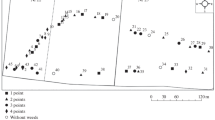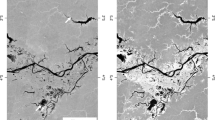Abstract
Retrospective satellite image data were evaluated for their ability to demonstrate the influence of center-pivot irrigation development in western Nebraska on spectral change and climate-related factors for the region. Periodic images of an albedo index and a normalized difference vegetation index (NDVI) were generated from calibrated Landsat multispectral scanner (MSS) data and used to monitor spectral changes associated with irrigation development from 1972 through 1986. The albedo index was not useful for monitoring irrigation development. For the NDVI, it was found that proportions of counties in irrigated agriculture, as discriminated by a threshold, were more highly correlated with reported ground estimates of irrigated agriculture than were county mean greenness values. A similar result was achieved when using coarse resolution Advanced Very High Resolution Radiometer (AVHRR) image data for estimating irrigated agriculture.
The NDVI images were used to evaluate a procedure for making areal estimates of actual evapotranspiration (ET) volumes. Estimates of ET volumes for test counties, using reported ground acreages and corresponding standard crop coefficients, were correlated with the estimates of ET volume using crop coefficients scaled to NDVI values and pixel counts of crop areas. These county estimates were made under the assumption that soil water availability was unlimited. For nonirrigated vegetation, this may result in over-estimation of ET volumes. Ground information regarding crop types and acreages are required to derive the NDVI scaling factor. Potential ET, estimated with the Jensen-Haise model, is common to both methods. These results, achieved with both MSS and AVHRR data, show promise for providing climatologically important land surface information for regional and global climate models.
Similar content being viewed by others
References
Bausch, W. C. and Neale, C. M. U.: 1983, Monitoring Corn Development Using Reflected Radiation, RNRF Symposium on the Application of Remote Sensing to Resource Management, Seattle, Washington, May 22–27, 1983, Proceedings, pp. 295–302.
Colwell, J. E.: 1983, ‘Regional Inventory by Joint Use of Coarse and Fine Resolution Satellite Data’, in International Symposium on Remote Sensing of Environment, 17th, Ann Arbor, Michigan, Proceedings: Environmental Research Institute of Michigan, pp. 1077–1083.
Deering, D. W. and Haas, R. H.: 1980, Using Landsat Digital Data for Estimating Green Biomass, National Aeronautics and Space Administration Technical Memorandum 80727, Greenbelt, Maryland, Goddard Space Flight Center, 21 p.
Estes, J. E., Stow, D., and Jensen, J. R.: 1982, ‘Monitoring Land Use and Land Cover Changes’, in Remote Sensing for Resource Management, pp. 100–110.
Hayes, L.: 1985, ‘The Current Use of TIROS-N Series of Meteorological Satellites for Land Cover Studies’, Int. J. Remote Sensing 6, 35–45.
Heilman, J. L., Heilman, W. E., and Moore, D. G.: 1982, ‘Evaluating the Crop Coefficient Using Spectral Reflectance’, Agronomy Journal 74, 967–971.
Hinkle, S. E., Gilley, J. R., and Watts, D. G.: 1984, Improved Crop Coefficients for Irrigation Scheduling, U.S. Department of Agriculture-Agricultural Research Service Report 58–9AHZ-9–454, Lincoln, Nebraska, Agricultural Engineering Department, University of Nebraska, 87 p.
Holben, B. N. and Fraser, R. S.: 1984, ‘Red and Near-Infrared Sensor Response to Off-Nadir Viewing’, Int. J. Remote Sensing 5, 145–160.
Holben, B. N., Tucker, C. J., and Fan, C.: 1980, ‘Spectral Assessment of Soybean Leaf Area and Leaf Biomass’, Photogrammetric Engineering and Remote Sensing, Falls Church, Virginia, American Society for Photogrammetry and Remote Sensing, Vol. 46, pp. 651–656.
Malila, W. A. and Anderson, D. M.: 1986, Satellite Data Availability and Calibration Documentation for Land Surface Climatology Studies, International Satellite Land Surface Climatology Project Report 5, National Aeronautics and Space Administration, Greenbelt, Maryland, Goddard Space Flight Center, 213 p.
Markham, B. L. and Barker, J. L.: 1987, Radiometric Properties of U.S. Processed Landsat MSS Data, Remote Sensing of Environment, New York, New York, Elsevier Science Publ. Co., Inc., Vol. 22, pp. 39–71.
Miller, D. H.: 1981, Energy at the Surface of the Earth, New York, Academic Press, 516 p.
Musick, H. B.: 1986, Temporal Change of Landsat MSS Albedo Estimates in Arid Rangeland, Remote Sensing of Environment, New York, Elsevier Science Publ. Co., Inc., Vol. 20, pp. 107–120.
Neale, C. M. U. and Bausch, W. C.: 1985, Crop Coefficients Derived from Reflected Canopy Radiation, American Society of Agricultural Engineers, Winter Meetings, Chicago, Illinois, Publication No. 83–2527.
Price, J. C.: 1987, Calibration of Satellite Radiometers and the Comparison of Vegetation Indices, Remote Sensing of Environment, New York, Elsevier Science Publ. Co., Inc., Vol. 21, pp. 15–27.
Price, J. C.: 1988, An Update on Visible and Near Infrared Calibration of Satellite Instruments, Remote Sensing of Environment, New York, Elsevier Science Publishing Company, Inc., Vol. 24, pp. 419–422.
Rao, C. R. N.: 1987, Pre-Launch Calibration of Channels 1 and 2 of the Advanced Very High Resolution Radiometer, National Oceanic and Atmospheric Administration/National Environmental Satellite, Data, and Information Services Technical Report 36, Washington, D.C., Satellite Research Laboratory, 62 p.
Ritchie, J. T. and Burnett, E.: 1971, ‘Dryland Evaporative Flux in a Subhumid Climate: II. Plant Influences’, Agronomy Journal 63, 56–62.
Ritchie, J. T., Rhoades, E. D., and Richardson, C. W.: 1976, ‘Calculating Evaporation from Native Grassland Watersheds’, Transactions of the American Society of Agricultural Engineers 19, 1098–1103.
Robinove, C. J., Chavez, P. S., Gehring, D., and Holmgren, R.: 1981, Arid Land Monitoring Using Landsat Albedo-Difference Images, Remote Sensing of Environment, New York, Elsevier Science Publ. Co., Inc., Vol. 11, pp. 113–156.
Roller, N. E. G. and Colwell, J. E.: 1986, ‘Coarse-Resolution Satellite Data for Ecological Surveys’, Bioscience 36, 468–475.
Stern, R. W.: 1965, ‘Evapotranspiration of Safflower at Three Densities of Sowing’, Australian Journal of Agricultural Research 16, 961–971.
Townshend, J. R. G. and Tucker, C. J.: 1984, ‘Objective Assessment of Advanced Very High Resolution Radiometer Data for Land Cover Mapping’, Int. J. Remote Sensing 5, 497–504.
Townshend, J. R. G. and Justice, C. O.: 1986, ‘Analysis of the Dynamics of African Vegetation Using the Normalized Difference Vegetation Index’, Int. J. Remote Sensing 7, 1435–1445.
Tucker, C. J.: 1979, Red and Photographic Infrared Linear Combinations for Monitoring Vegetation, Remote Sensing of Environment, New York, Elsevier Science Publ. Co., Inc., Vol. 8, pp. 127–150.
Tucker, C. J., Holben, B. N., Elgin, J. A., and McMurtrey, J. E.: 1981, Remote Sensing of Total Dry Matter Accumulation in Winter Wheat, Remote Sensing of Environment, New York, Elsevier Science Publ. Co., Inc., Vol. 11, pp. 171–189.
Tucker, C. J., Gatlin, J. A., and Schneider, S. R.: 1984, Monitoring Vegetation in the Nile Delta with NOAA-6 and NOAA-7 AVHRR Imagery, Photogrammetric Engineering and Remote Sensing, Falls Church, Virginia, American Society for Photogrammetry and Remote Sensing, Vol. 50, pp. 53–61.
U.S. Bureau of Reclamation: 1983, Estimating Agricultural Crop Water Requirements, Technical Guideline for Bureau of Reclamation, Water Utilization Section, Engineering and Research Center, Denver, Colorado, 31 p.
Weiser, R. L., Asrar, G., Miller, G. P., and Kanemasu, E. T.: 1986, Assessing Grassland Biophysical Characteristics from Spectral Measurements, Remote Sensing of Environment, New York, Elsevier Science Publ. Co., Inc., Vol. 20, pp. 141–152.
Wiegand, C. L., Richardson, A. J., and Kanemasu, E. T.: 1979, ‘Leaf Area Index Estimates for Wheat from Landsat and Their Implications for Evapotranspiration and Crop Modeling’, Agronomy Journal 71, 336–342.
Author information
Authors and Affiliations
Additional information
TGS Technology, Inc. Work performed under U.S. Geological Survey contract 14-08-0001-22521;
Rights and permissions
About this article
Cite this article
Seevers, P.M., Sadowski, F.C. & Lauer, D.T. An investigation of spectral change as influenced by irrigation and evapotranspiration volume estimation in western Nebraska. Climatic Change 17, 265–285 (1990). https://doi.org/10.1007/BF00138371
Received:
Revised:
Issue Date:
DOI: https://doi.org/10.1007/BF00138371




